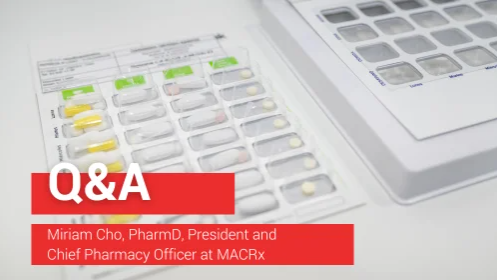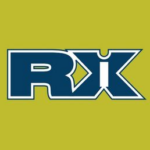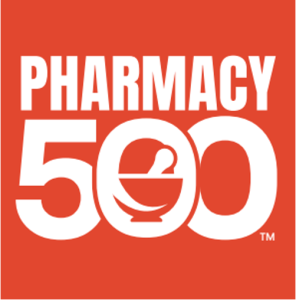Contributed by Miriam Cho, PharmD, President and Chief Pharmacy Officer at MACRx
Q. What strategies or tools have you found most effective in improving patient medication adherence and compliance?
Improving patient medication adherence and compliance is a significant challenge, but several strategies and tools have proven effective. These strategies aim to address various barriers, such as lack of understanding and the complexity of regimens. Here are three practical approaches:
- Patient Education: Providing patients with clear, understandable information about their condition and the importance of their medication can motivate them to adhere to prescribed treatments.
- Technology-Based Solutions: Patients increasingly rely on technology, and using apps or devices to manage medication adherence can help remind and guide them. Electronic Health Records (EHR) are integrated systems that can prompt healthcare providers to follow up with patients who miss doses and increase adherence.
- Pharmacist Involvement: Pharmacists are accessible healthcare professionals who can provide one-on-one counseling, offer reminders, and educate patients and nursing staff. Many pharmacies provide medication therapy management (MTM) services, where pharmacists review medication regimens, resolve issues, and provide tailored advice.
Q. What role do automation and AI play in supporting patient adherence and compliance, and are there specific technologies, platforms, or tools you recommend?
Automation and AI have become essential in improving patient adherence and compliance with treatment plans. AI and automation systems can send tailored reminders to patients about when to take their medications, helping them avoid missing doses. These reminders are adjusted based on patient preferences or specific treatment schedules. AI can even detect patterns and send additional reminders as needed.
Various platforms exist for ease of use for the public and in the LTC space. Patients can explore options available and supported by their employers or insurance benefits to see if one best fits their needs.
Q. How can a pharmacy incorporate adherence packaging into its workflow?
Pharmacies have a wide range of options to explore when integrating adherence packaging/automation into their daily operations. First, they should choose the type of packaging that best suits their model and client base. Options can include, but are not limited to:
- Blister Packs: Pack medications by day, time of day (morning, afternoon, evening), or specific doses.
- Multi-Dose Systems: Combination packs that group multiple medications for patients taking several drugs simultaneously.
- Unit-Dose Systems: Packaging medications individually for each dose, which may be helpful for patients with complex regimens.
Next, operators should validate that it can integrate with their pharmacy management system. Following confirmation, it is critical to schedule and plan for pharmacy staff training, from assembly, supplies, maintenance, and cleaning to incorporation in daily fulfillment. These processes and procedures should include pharmacists and technicians and should be compliant with the state in which the pharmacy resides.
Lastly, taking the time to set up a system for tracking adherence packaging errors or patient complaints and continuously improving the process can be beneficial to ensure that best practices are followed and maintained after execution.
Q. What are the cost implications of different adherence packaging solutions, and how do you balance cost efficiency with improved patient outcomes?
Executing and analyzing ROI on any automation before investing is critical for any pharmacy or operation. The ROI should not only include the cost of the equipment, installation, staff training, supplies, and interface fees but also the number of years it takes to pay off the automation, i.e., the payback model. As an example, if the cost of automation is $850,000, with a labor savings of $450,000 annually, it would take 1.8 years to pay off the automation and then reach profits.
Conversely, with proper planning, education, and execution, the nursing facility, staff, and patients can benefit as soon as the first dispense. Each type of packaging can leverage several advantages from the facility’s perspective, including but not limited to reduced medication pass times, improved adherence, accountability, and compliance.
Q. How do you handle medication synchronization (Med Sync) for residents in skilled nursing facilities (SNFs) or assisted living communities with frequently changing medication regimens?
Synchronizing medications can be vital to reducing nursing time, aligning internal operations and schedules, and improving medication adherence. We execute a variety of proprietary approaches as we navigate medication changes to ensure that compliance and resident outcomes are priorities. Especially in the SNF setting where medication changes are frequent, ensuring good communication and alignment of pharmacy-facility operations becomes vital to positive patient outcomes.
Q. How do you collaborate with nursing staff and caregivers to ensure compliance and reduce medication administration errors in LTC facilities?
Collaboration with nursing staff and caregivers in long-term care (LTC) facilities is crucial for reducing medication administration errors and ensuring compliance. All operational guidelines must be communicated clearly and effectively to the facility staff to ensure they understand ordering cutoffs, delivery parameters, medication changes, and urgent request needs. Regular discussions about patient care, medication updates, and potential issues help address concerns before they become problems.
LTC pharmacies can also offer medication reconciliation to ensure all team members know the current medications, dosage changes, and patient preferences. Regular reconciliation of patient medication lists ensures that discrepancies are immediately addressed. Establishing clear, consistent protocols for administering medication — such as the “five rights” (right patient, right medication, right dose, right time, right route) — ensures everyone follows the same steps.
Utilizing EHR systems for real-time medication tracking can alert staff to potential drug interactions, allergies, and dose errors, improving overall safety.
Lastly, collaborating with pharmacists to review patient medications regularly helps identify issues such as inappropriate dosages, interactions, and drug substitutions. Pharmacists can also train the nursing staff on the specifics of medications.
Communication is key to the success of the facility-pharmacy partnership.
Q. How do you manage compliance challenges with controlled substances and PRN medications in a long-term care setting while ensuring proper documentation and regulatory compliance?
Compliance has been and always will be the backbone of any pharmacy operation. Establishing a high focus on understanding the regulations in your state is critical to success. Our operations have a compliance team that maintains and implements strict documentation protocols and audits prescriptions to ensure that controlled substances and PRN medications are properly ordered and maintained. We use a paperless document tracking system for controlled substances as a safeguard so that there is an end-to-end chain of custody when medications are transferred and delivered.
Internally, we utilize physical controls, such as locked storage, daily counts, limited access, cameras, system controls, and audits. We also provide medications supporting barcode scanning administration so that our facility partners can effectively manage controlled substances and PRN medications in long-term care.
Q. How do you integrate adherence packaging with electronic medication administration records (eMARs) to ensure seamless tracking and compliance?
Education around best practice guidelines and procedures as well as collaboration with your client ensures a seamless and compliant model. Electronic health record systems have allowed almost instantaneous communication so that we are always up to date on medication changes. By utilizing electronic interfaces, ADT, HL-7, and other routes, a pharmacy can improve their accuracy to the changing needs of the residents we serve. Proper workflows and maintenance are critical as with any type of automation to ensure that you are feeding in the best information to get the highest quality output.
Q. What are some innovative ways to collaborate with healthcare providers to improve medication adherence and patient care?
Direct access to healthcare providers via applications that allow for secure messaging, smartphone access, and reminders can improve clarification delays, medication turnaround time, and overall patient care. In addition, having multiple communication platforms assists in ensuring a cohesive interdisciplinary team has eyes on resident care and outcomes, allowing a comprehensive care team. Lastly, we have seen many advances in the utilization of AI that show promising future approaches to advance patient care.








